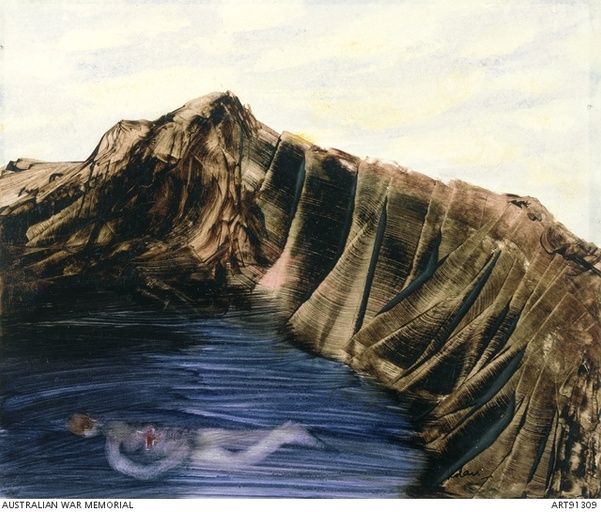

Drowned soldier at Anzac as Icarus, 1958
Sidney Nolan Drowned soldier at Anzac as Icarus 18 November 1958 textile dye, sgraffito, coloured crayon on coated paper 25.4 x 30.4 cm,
Professor Paul Gough is Pro Vice-Chancellor and Vice-President of RMIT University, Melbourne, Australia. He is a painter, broadcaster and writer he has exhibited internationally and is represented in the permanent collection of the Imperial War Museum, London, the Canadian War Museum, Ottawa, and the National War Memorial, New Zealand. In addition to painting Gallipoli and the battlefields of the Western Front he has published widely about war art, commemoration and remembrance of wars.
"Today few painters can approach the subject of Gallipoli without reference to the extraordinary suite of paintings created by Sidney Nolan. Between the mid-1950s and the late 1970s he painted over 250 striking images of the most infamous peninsular in modern history. Yet Nolan spent only a day on the former battlefield in 1956. It left an indelible memory.
‘I stood on the place where the first ANZACs had stood, looked across the straits to the site of ancient Troy, and felt that here history had stood still’, he recalled. ‘I visualised the young, fresh faces of the boys from the bush, knowing nothing or war of faraway places, all individuals, and suddenly all the same – united and uniform in the dignity of the common destiny.’
Fusing the bare hills of the Dardanelles with the harshness of the Australian bush, Nolan blurred one iconic landscape into another. Using his trademark materials – textile dye, polymer medium, coloured crayon, coated paper – he created bare, almost minimal, images suffused with colour, executed hastily, without wasted effort.
As memoryscapes they are compelling. They conjure up the crowded emptiness of the forbidding terrain of No-Man’s-Land. Offshore, a dead or dying soldier, floats in a cobalt sea. Nolan’s brother had drowned in 1945 and the beaches off Gallipoli had claimed the lives of hundreds of ANZACs and their allies in 1915. Here, a forlorn Icarus lies facedown in the indifferent ocean.
Poignant and bleak, these paintings meld agonising personal and public memories. Nolan evokes rich layers of recall and emotion, rendering the landscape silent witness to both historic and very contemporary events."